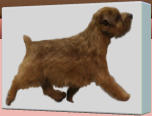

Breeders Corner

Kafka said, "All knowledge, the
totality of all questions and
answers, is contained in the dog."

Please submit your article,
publication or hyperlink to an
article to Judi Hartell.
DataDawg@Austin.rr.com
Submissions

Quote



The Bluebonnet Norfolk Terrier Club does not recommend,
guarantee, endorse, nor rate these recommendations or
contributors, their kennel or their stock. The purpose of this section
is to share the knowledge and experience of breeders who have vast
experience in whelping and raising puppies. The tips and tricks
below are intended to augment qualified veterinarian care, not as a
substitute for qualified veterinarian care of the dam and puppies.









Drawing The Lines: A look at why some sire lines fade and other flourish. (This article
was written about horses but applies to dog breeding as well.





The traits produced by a gene can be characterized as dominant or recessive.
Dominant traits can be expressed when only one copy of the gene for that trait is present.
Recessive traits carried on autosomal chromosomes can be expressed only when two
copies of the gene are present (because the gene on the paired chromosome is usually
expressed instead). Dogs with one copy of an abnormal gene for a recessive trait (and who
thus do not have the disorder) are called carriers. With codominant traits, both copies of a
gene are expressed to some extent. An example of a codominant trait is blood type. If a dog
has one gene coding for blood type A and one gene coding for blood type B, the person has
both blood types (blood type AB).
Whether a gene is X-linked (sex-linked) also determines expression. Among males, almost
all genes on the X chromosome, whether the trait is dominant or recessive, are expressed
because there is no paired gene to offset their expression.
Behavior patterns are hereditary. Breed for them.

Recessive Traits: Rules of Thumb:
1. The trait may skip one or more generations.
2. Only those individual who carry a pair of the determiners display the trait.
3. An animal carrying only one determiner can be discovered only by being mated to another
carrying the same determiner.
4. To be evident, the trait must come from both sides of the family.


- Behavior
- Honor Roll
- Living With Norfolk Terriers
- Fun With Your Norfolk
- Tip Of The Week
- Publications
- Therapy and Service Dogs
- Health & Nutrition
- Competition


- Books
- Clubs
- Collectibles, Gifts & Fun Activities
- Companion Animal Recovery
- Dog Show Superintendents
- Genetics
- Health Related Sites
- Canine Health Links
- Vaccination Protocols
- Animal Health Trust
- Online Mendelian Inheritance In Animals
- Univ. Of Cambridge Vet. School
- Canine Inherited Disorders Database
- All Creatures Veterinary Hospital
- A First Aid Kit
- Veterinary Pet Insurance
- AKC Pet Health Plan
- Cornell Univ. College of Vet. Medicine
- More Health Related Sites
- Independent Sites
- Pet Travel
- Training Your Puppy
- Publications


- Breeding Tips
- Breeding Tips Page One
- Breeding Tips Page Two
- Breeding Tips Page Three
- Breeding Tips Page Four
- Breeding Tips Page Five
- Breeding Tips Page Six
- Virus &The Pregnant Bitch
- Dog Neutering Video
- Vaccinations & The Pregnant Bitch
- Incontinence In The Pregnant Bitch
- Flagyl & The Pregnant Bitch
- Canine Reproduction
- Frozen vs Chilled Semen
- Modern Breeding Management
- Dialogue On Rasberry Leaves
- Monitoring Pregnancy
- Uses For Vaginal Cultures
- OFA & The Pregnant Bitch
- Breeding Tips Page Seven
- Breeding Tips Page Eight
- Breeding Tips Page Nine
- Breeding Tips Page Ten
- Breeding Tips Page Eleven
- Breeding Tips Page Twelve
- Breeding Tips Page Thirteen
- Breeding Tips Page Fourteen
- Genetics And Inheritance
- Rescue









